POPULATION OF WOMEN AND MEN
Davao Region had a total population of 5,243,536 individuals based on the 2020 Census of Population and Housing (2020 CPH). This total population is comprised of 99.6 percent or 5,223,802 household population and 0.4 percent institutional population.
Of the household population, 51.3 percent or 2,678,976 individuals were males and 48.7 percent or 2,544,826 individuals were females. By age group, children under 15 years made up a significant portion of the population, totaling 1,637,285 individuals (31.3%). Among them, the largest age group was 5–9 years (551,361), followed closely by 10–14 years (543,958). Notably, in each age group up to age 54, men outnumbered women. However, beginning in the 60–64 age bracket, women began to outnumber men, and this trend became more pronounced in older age groups. For example, among those aged 80 and above, women numbered 23,923 compared to 15,218 men—reflecting the longer life expectancy of women.
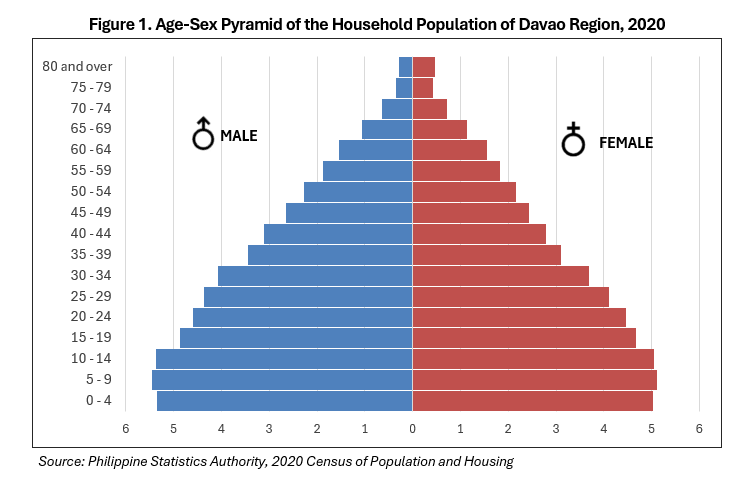
The working-age population (15–64 years) comprised the majority at 3,321,859 (63.6%). Males still slightly outnumbered females in this group. There were 3,284,277 individuals aged 18 and over, and a substantial elderly population (aged 60 and over) of 426,822—of which women formed the majority at 224,833 (52.7%).
WOMEN AND MEN IN AGRICULTURE
Agricultural Operators
Between 2012 and 2022, the total number of agricultural operators in Davao Region increased from 338,032 to 482,891, representing a 43.0 percent growth in the sector. This growth was accompanied by notable shifts in age and gender composition of agricultural operators. While men continued to dominate the industry, their overall percentage declined across most age groups, whereas female participation increased steadily. This shift indicates a slow but meaningful movement toward gender balance in agriculture (Table 1 and Figure 2).
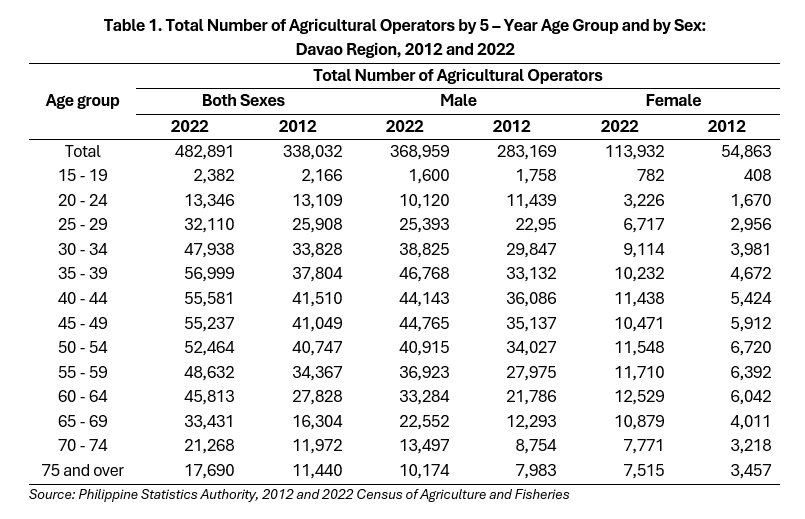
One of the most significant trends was the decline in young male agricultural operators. In the 15 – 29 age group, male representation dropped, particularly in the 20 – 24 and 25 – 29 brackets, suggesting waning interest in agriculture among younger men. On the other hand, female representation in younger age groups saw slight growth, indicating that while the overall youth participation in agriculture is declining, more women are gradually becoming involved. The population pyramid illustrates this shift, where the base is narrower for young men in 2022 compared to 2012, while for young women, there is a slight broadening, signifying increased representation.
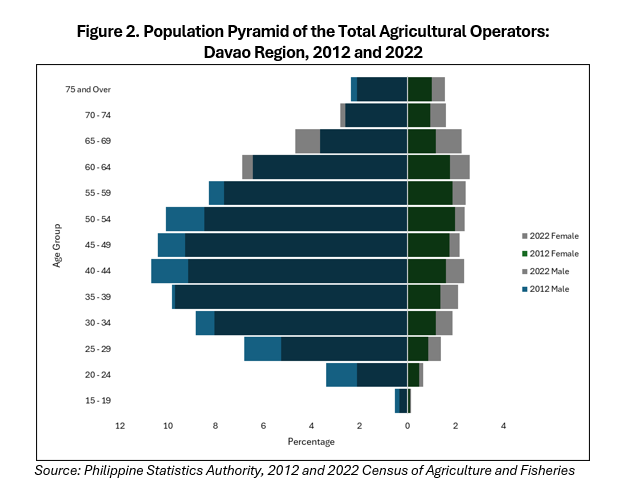
In contrast, middle-aged agricultural operators (30 – 59 years) remained the dominant segment, though some shifts occurred within this group. The male percentage in this bracket declined slightly, while the female percentage saw a notable increase, especially among those aged 35 – 44 which indicates that women are taking on a larger role in agriculture during their prime working years.
The most striking demographic change occurred among older agricultural operators (60+ years). Here, both male and female participation increased, indicating that agriculture is becoming increasingly reliant on an aging workforce. This trend raises concerns about succession planning and the future sustainability of farming. The increase in older female operators suggests that women are either remaining active in agriculture for longer periods or entering the field later in life, possibly due to widowhood, inheritance, or shifts in economic necessity. Meanwhile, the growth in older male operators suggests that many farmers continue working well beyond traditional retirement age, either due to a lack of younger successors, economic dependence, or cultural factors that encourage older individuals to remain engaged in farming.
Fishing Operators
The number of fishing operators in the Davao Region experienced a significant increase over the decade from 2012 to 2022. In 2012, there were 22,608 fishing operators, which rose by 65.5 percent to 37,409 operators in 2022. This increase suggests a growing reliance on or participation in the fishing industry.
Examining the data by gender, male fishing operators continue to dominate the industry, though their numbers grew at a slightly slower pace than the overall increase. In 2012, there were 22,017 male fishing operators, and by 2022, this number had risen to 35,644—an increase of 62.0 percent. This demonstrates that while fishing remains a male-dominated occupation, the overall rise in participation suggests expanding fishing activities (Figure 3).
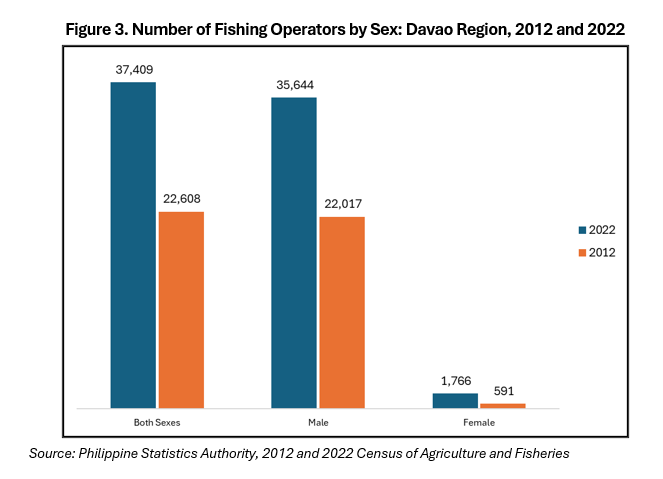
The most remarkable growth occurred among female fishing operators. In 2012, only 591 women were recorded as fishing operators, but by 2022, their number surged to 1,766—a staggering nearly 200% increase. Although women still represent a small fraction of the total fishing workforce, this sharp increase suggests that women are becoming more involved in fishing-related activities, whether in direct fishing operations or supporting roles within the industry. This trend could be influenced by changing societal norms, economic necessity, or local programs encouraging female participation in fisheries.
Agricultural Population
Agricultural population refers to individuals aged 18 and above who were members of households with at least one agricultural operator. In 2022, Davao Region had an agricultural population of 1,170,680 individuals.
Of this number, 52.2 percent were males (610,627 individuals) and 47.8 percent females (560,053 individuals). This indicates that while men still form the majority in the agricultural workforce, the gap between male and female participation is relatively narrow, suggesting a significant female presence in the sector (Figure 4).
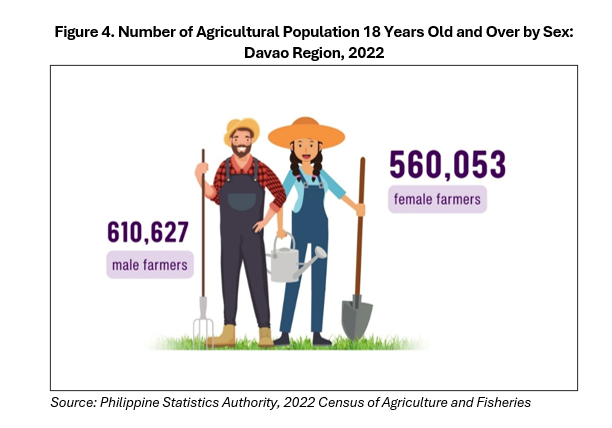
Overall, while men remain the majority in the agricultural sector across the region, the consistent presence of women, comprising nearly half of the agricultural population highlights their increasing role in farming and agricultural activities. The data suggests that agriculture is not solely male-dominated but includes substantial female participation.
Agricultural Population with Ownership or Secure Rights over Agricultural Land
Agricultural population with ownership or secure rights over agricultural land refers to agricultural population with legally recognized documents of ownership of agricultural land or the right to sell it or the right to bequeath it over the total agricultural population.
Of the total agricultural population in the region, individuals who reported owning or having secure rights over their agricultural land accounted for 25.3 percent or 296,723. Of this, 210,428 or 70.9 percent are males, while 86,295 or 29.1 percent are females (Table 3).

Across provinces and HUC, the province of Davao de Oro stood out with the highest proportion of its agricultural population 18 years old and over (33.2%) holding ownership or secure rights over agricultural land. This was followed by City of Davao (26.8%) and Davao Oriental (24.7%). Davao Occidental had the lowest proportions of their agricultural population with secure rights over agricultural land at 21.0 percent.
Among male agricultural population, 34.5 percent hold secure rights over agricultural land. Meanwhile, only 15.4 percent of the female agricultural population have ownership or secure rights. This highlights a significant gender disparity, with women being 19.1 percentage points less than men to own or have secure rights to agricultural land (Table 4).
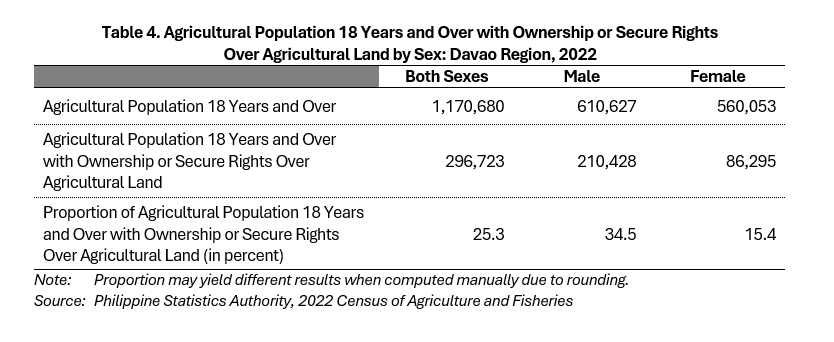
During the same reference period, 125,710 of the agricultural population aged 18 and over reported full ownership of their agricultural land, meaning they held a formal title of ownership. Of these, 85,033 (67.6%) were males, while 40,677 (32.4%) were females. Davao Occidental led in female full ownership of agricultural land, with 38.6 percent, followed by Davao de Oro and Davao del Sur with 33.7 percent and 32.9 percent, respectively (Table 5).
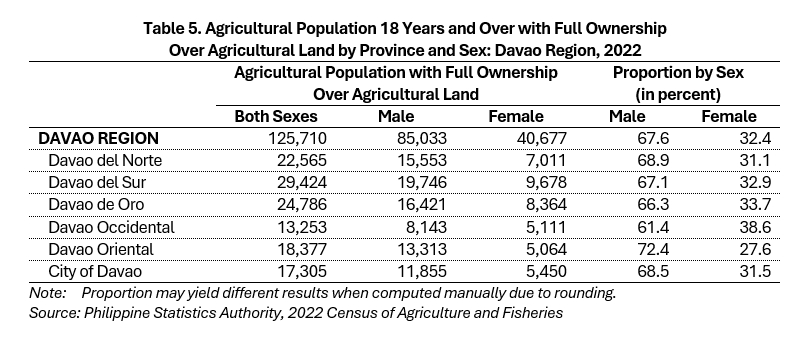
Agrarian Reform Beneficiaries and Holders of Emancipation Patent (EP) and Certificate of Land Ownership Award
Emancipation Patents and Certificate of Land Ownership Award is a document evidencing ownership of the land which is granted or awarded to the Agrarian Reform Beneficiaries. It contains the restrictions and conditions provided in the Comprehensive Agrarian Reform Law (CARL).
As of 2022, there were 153,874 agrarian reform beneficiaries holding Emancipation Patent and Certificate of Land Ownership Award in Davao Region. Of this number 33.5% were women and 66.5% were men (Figure 5).

This gender disparity highlights the continued male dominance in land ownership and access to agrarian reform benefits in the region, despite policies aimed at promoting equitable land distribution.
Beneficiaries of Community-Based Forest Management Agreement (CBFMA)
Community Based Forest Management Agreement (CBFMA) is a production sharing agreement between the DENR and the participating people’s organization (POs) for a period of 25 years renewable for another 25 years and shall provide tenurial security and incentives to develop, utilize and manage specific portions of forest lands.
The total number of beneficiaries of the CBFMA decreased from 14,743 in 2022 to 13,778 in 2023, reflecting a 6.54 percent decline (Figure 6).
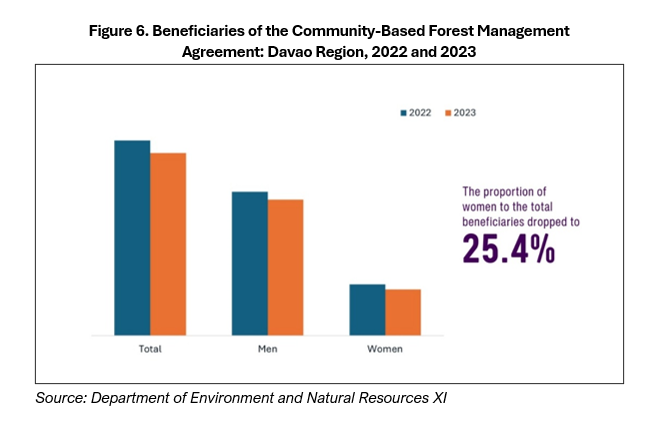
The participation of both men and women in CBFMA also declined. Highlighting women, the number of women beneficiaries decreased from 3,884 or 26.3 percent in 2022 to 3,494 or 25.4 percent in 2023, marking a 10.04 percent decline in absolute numbers and a slight drop in their proportion of the total beneficiaries.
WOMEN AND MEN IN EDUCATION
Enrolment in Elementary and Secondary Schools
For the school year 2022-2023, enrollment data for elementary and secondary schools in the Davao Region indicates a steady participation of students across both levels, with notable differences in gender distribution.
In elementary schools, the total enrollment reached 775,865 students, with 404,113 boys (52.1%) and 371,752 girls (47.9%). This reflects a higher number of male students compared to female students (Figure 7).
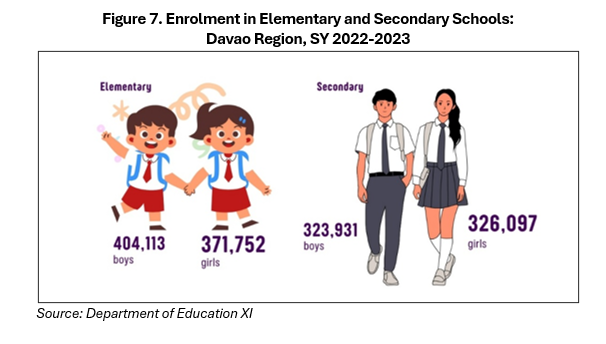
Meanwhile, enrolment in secondary schools reached 650,028 students, with a slightly balanced gender distribution: 323,931 boys (49.8%) and 326,097 girls (50.2%). Unlike in elementary education, where boys are the majority, secondary education shows a nearly equal participation rate between genders, with a slight predominance of girls which indicate an increased retention of female students in higher levels of education.
Enrolment in Higher Education Institutions
The gender gap in education continues to widen in tertiary level. For the academic year 2023-2024, women outnumbered men in enrolment in higher education institutions in Davao Region, i.e., 56.8 percent of the total enrolment were women while 43.2 percent were men (Figure 8).
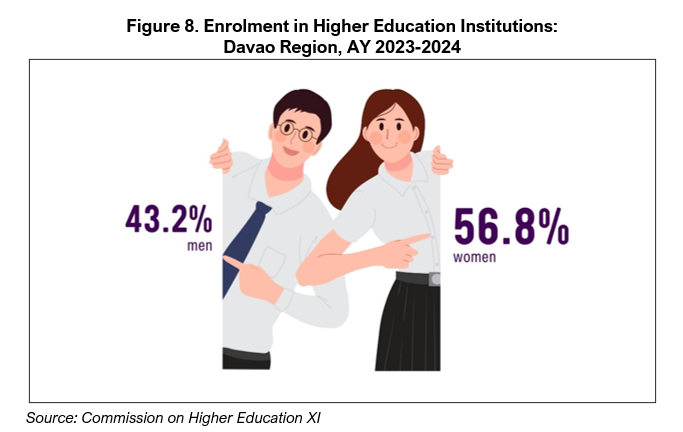
In terms of field of study, there were more women than men in Architecture and Town Planning, Business Administration and Related Field, Education Science and Teacher Training, Home Economics, Humanities, Law and Jurisprudence, Mass Communication and Documentation, Mathematics, Medical and Allied, Natural Science, Service Trades, Social and Behavioral Sciences, and Other Disciplines.
Graduates in Technical Vocational Courses
The total graduates in technical and vocational courses in 2024 reached 86,821, reflecting the continued importance of skills development in various trades and industries. Of this number, 44,500 graduates or 51.3 percent were women, slightly outnumbering their male counterparts. This indicates a positive trend toward gender balance in technical and vocational education and training (TVET), a field that has traditionally been male-dominated (Figure 9).
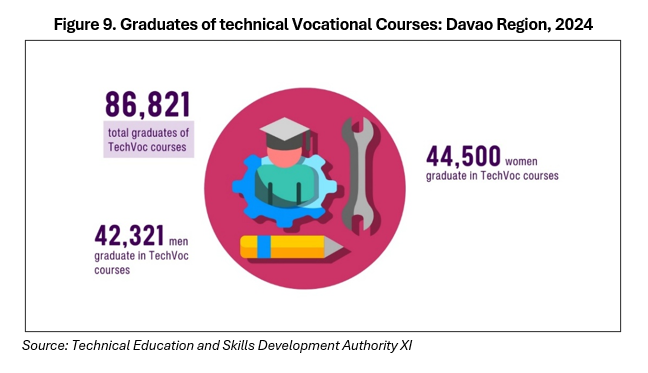
Mostly, women graduated in Social, Community Development and Other Services, Tourism (Hotel and Restaurant), and Agriculture, Forestry and Fishery sectors.
WOMEN IN BUSINESS AND EMPLOYMENT
Small- and Medium-Sized Enterprises/Business Name Registration
In the Philippines, SMEs are defined by the Department of Trade and Industry as any enterprise with 10 to 199 employees and/or assets valued from P3 million to P100 million.
The total number of registered SMEs stands at 19,066. A significant majority of these businesses, approximately 60.6 percent, are owned or registered by women, totaling 11,553 enterprises. In contrast, men account for 39.4 percent of SME registrations which suggests a strong presence of women entrepreneurs in the region, indicating potential trends in gender dynamics within business ownership (Figure 10).

Overseas Filipino Workers with Documents Processed in POEA
In 2021, there were 31,958 OFWs who processed documents in POEA. Of this number, 48.2% were newly-hired, 13.6% were re-hired OFWs, and 38.2% were sea-based OFWs. The percentage of women among newly-hired, re-hired, and sea-based OFWs were 90.3%, 65.3%, and 3.5%, respectively (Figure 11).
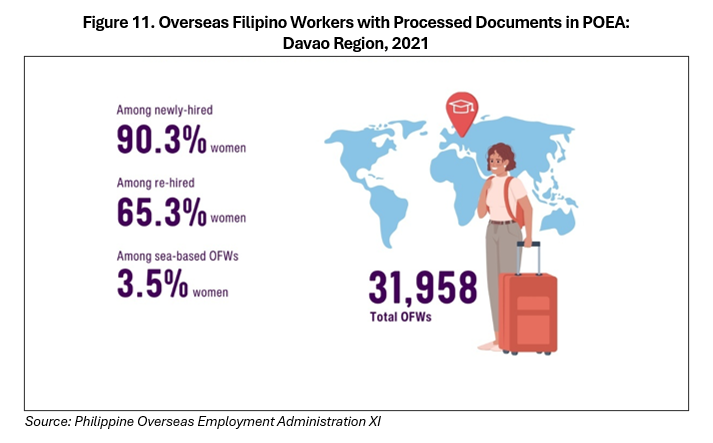
These figures highlight the strong presence of women in land-based overseas employment, particularly in new deployments, while also emphasizing their limited participation in maritime work.
WOMEN IN GOVERNMENT AND PUBLIC SECTOR
Inventory of Government Human Resources
Women representation varies significantly across different categories of government employment. The inventory of government human resources revealed that as of 30 June 2024 there were a total of 141,247 individuals working in the government in the region. Of this number 50.9 percent were women.
Of the 141,247 government workers, 53.9 percent were classified as career service workers,
4.9 percent were non-careers, and 41.2 percent were Job Orders and Contract of Service workers (Figure 12).
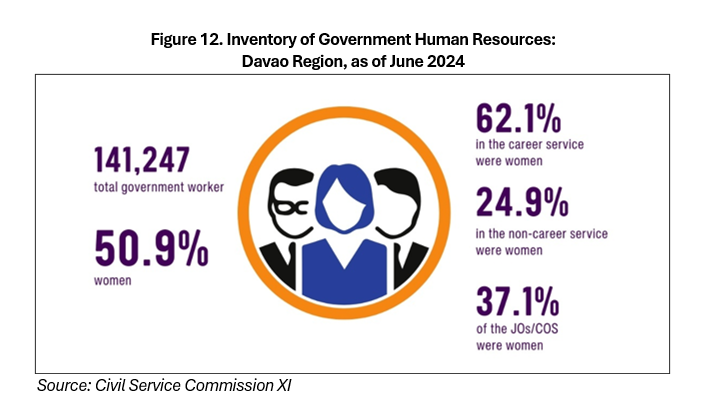
Zooming in, 62.1 percent of those in the career service, 24.9 percent of those in non-career service, and 37.1 percent of JOs and COS were women.
Digging deeper, the first level positions in the career service of the government, which typically include entry-level roles or those requiring less responsibility, were dominated by men. Only 45.4 percent of first level positions were held by women (Figure 13).
In contrast, second level positions, which often involve more complex tasks or supervisory responsibilities, were held mostly by women, that is, 66.4 percent.

Elected Officials by Position
When it comes to elective positions in the government, the gender gap is more pronounced. These roles, which include positions such as mayors, governors, legislators, and other publicly elected officials, are still largely dominated by men.
Results of the 2022 elections showed that in Davao Region, only 141 out of the 587 elective positions were held by women (Figure 14).
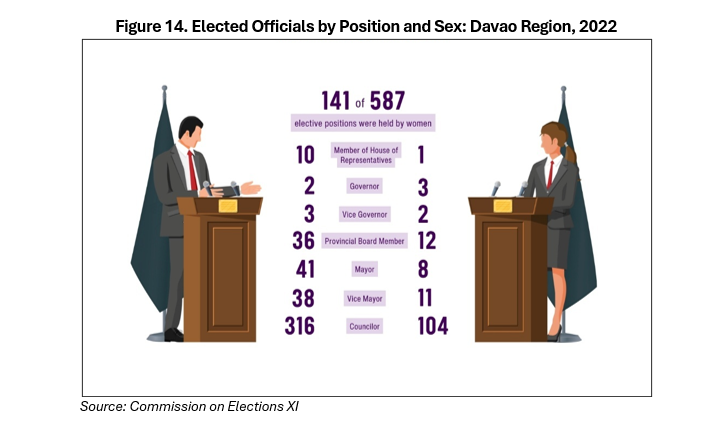
Despite efforts to promote gender equality and women's political participation, women remain significantly underrepresented in this arena.
APPROVED FOR RELEASE:
RANDOLPH ANTHONY B. GALES
(Chief Statistical Specialist)
Officer-In-Charge
Regional Statistical Services Office 11
Data Sources
The Philippine Statistics Authority – Regional Statistical Services Office Davao Region extends its sincerest appreciation to all offices and departments who promptly submitted and provided their data for the production of our Women and Men Handbook.
- Department of Agrarian Reform XI
- Department of Environment and Natural Resources XI
- Department of Education XI
- Commission on Higher Education XI
- Technical Education and Skills Development Authority XI
- Department of Trade and Industry XI
- Philippine Overseas Employment Administration XI
- Civil Service Commission XI
- Commission on Elections
